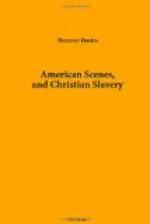Take another instance, on the same authority:—
“Not very long ago, in Lincoln County, Kentucky, a female slave was sold to a Southern slaver under most afflicting circumstances. She had at her breast an infant boy three months old. The slaver did not want the child on any terms. The master sold the mother, and retained the child. She was hurried away immediately to the depot at Louisville, to be sent down the river to the Southern market. The last news my informant had of her was that she was lying sick, in the most miserable condition, her breast having risen, inflamed, and burst!”
Let another case, testified by the Rev. C.S. Renshaw, add to the fame of this infamous city.
“Hughes and Neil traded in slaves down the river: they had bought up a part of their stock in the upper counties of Kentucky, and brought them down to Louisville, where the remainder of their drove was in jail waiting their arrival. Just before the steam-boat put off for the lower country, two negro women were offered for sale, each of them having a child at the breast. The traders bought them, took their babes from their arms, and offered them to the highest bidder; and they were sold for one dollar a piece, whilst the stricken parents were driven on board the boats, and in an hour were on their way to the New Orleans market. You are aware that a young babe diminishes the value of a field hand in the lower country, while it enhances her value in the breeding States.”
February 21.—Another dreary Sabbath on board. The principal objects of interest pointed out to us on that day were the residence and the tomb of the late President Harrison. The latter is a plain brick erection, in the midst of a field on the top of a hill, about half a mile in the rear of the former. The recollection of that man, so highly elevated, and so quickly cut down, could hardly fail to suggest a train of not unprofitable reflections. He was, I suppose, a moral and well-meaning man, distinguished for qualities not often to be found in high places; but I was sorry to be obliged to infer that much of what I had heard respecting the religiousness of his character wanted confirmation.
At half-past 4 P.M. we arrived at the long-wished-for Cincinnati—the “Queen of the West.” Our voyage from New Orleans had thus occupied twelve days, during which time we had been boarded and lodged, as well as conveyed over a space of 1,550 miles, for 12 dollars each, or one dollar per diem! It was the cheapest, and (apart from the companionships) the most pleasant mode of travelling we had ever experienced. As the boat stayed but a couple of hours at Cincinnati, we had to land without delay. Being a stranger in a strange land, I inquired for the Congregational minister, and was told that his name was Boynton. In perambulating the streets in search of his house, I was pleased to see but one shop open. It was a tailor’s, and, as I afterwards learned, belonged




